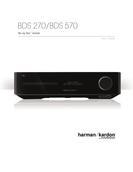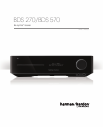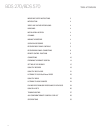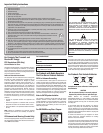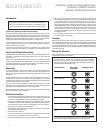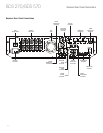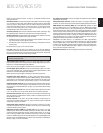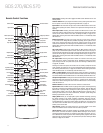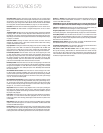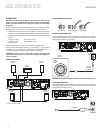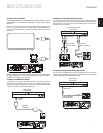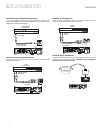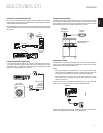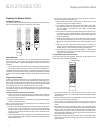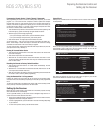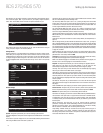
ENglIsh
7
Receiver Rear-Panel Connections
NOTE: See the Connections section, on page 10, for detailed information about
making connections.
Main Power switch: This mechanical switch turns the BDS receiver’s power supply
on or off. After you have made and verified all connections (see the Connections
section, on page 10), set this switch to the “On” position. During normal use you will
usually leave this switch set to On; it cannot be turned on or off using the remote
control. To conserve energy when you’re not going to be using the receiver for an
extended period of time, set this switch to “Off.”
AC Power connector: After you have made and verified all other connections, plug
the supplied AC power cord into this input and into an unswitched AC outlet.
Speaker connectors: Use the speaker wires supplied with the speakers to connect
the satellite and center speakers to the proper terminals.
• The BDS 570 receiver (shown) has connections for five speakers: front left, front
right, surround left, surround right and center.
• The BDS 270 receiver (not shown) has connections for two speakers: front left
and front right.
See Connections, on page 10, for more information.
Fan vents: These vents are used by the receiver’s fan to cool the unit. Maintain a
clearance of at least three inches (75mm) from the nearest surface to avoid overheating
the unit. It is normal for the fan to remain off at most normal volume levels. An automatic
temperature sensor turns the fan on only when it is needed.
IMPORTANT NOTE: Never block the fan vents. Doing so could allow the BDS receiver
to overheat to dangerous levels.
Optical Digital Input connectors: Connect the optical digital output of an audio-
only source component here. The signal may be a Dolby
®
Digital bitstream, a DTS
®
bitstream or a standard PCM digital-audio bitstream.
NOTE: Use only one type of digital connection for each source component.
Coaxial Digital Input connector: Connect the coaxial digital output of an audio-
only source component here. The signal may be a Dolby Digital bitstream, a DTS
bitstream or a standard PCM digital-audio bitstream.
NOTE: Use only one type of digital connection for each source component.
Component Video Input connector: If you have a video source device that has a
component video connector (and does not have an HDMI connector), use the component
video connector. You will also need to make an audio connection from the device to the
BDS receiver’s Aux In 1 connectors. See Connections, on page 11, for more information.
Subwoofer Output connector: Use the supplied mono RCA audio cable (with the
purple connectors) to connect this jack to the subwoofer’s Line-Level In LFE jack.
See Connecting a Powered Subwoofer, on page 10, for more details about making
connections.
Subwoofer Trigger connector: This connector provides 12V DC whenever the receiver
is on. It can be used to turn on and off other devices such as a powered subwoofer.
Remote IR Input connector: When the IR sensor on the front panel is blocked (such as
when the receiver is installed inside a cabinet), connect an optional IR receiver to the
Remote IR Input connector.
BD-Live connector: To be able to use the BD-Live feature, connect this port to
your local area network (LAN) using a Cat. 5/Cat. 5E network cable. See BD-Live
Interactivity, on page 22, for details.
Analog Audio Input connectors: Use these connectors to connect to an audio-
only source component (such as a tape deck). Do not connect a turntable to these
connectors without a phono preamp.
HDMI Input connectors (HDMI ver. 1.4a with 3-D): You can connect up to three
additional source devices that have HDMI connectors to the BDS receiver. The HDMI
connection transmits digital audio and video signals between devices, so you do not
have to make any additional audio connections for devices you connect via an HDMI
connector. The BDS receiver will pass 3-D video signals from 3-D capable HDMI source
devices to the TV via the HDMI Monitor Out connector. See Connecting Your HDMI Source
Devices, on page 11, for more information.
The Bridge IIIP connector: Connect The Bridge IIIP iPod/iPhone dock (available
separately) to this terminal.
Analog Audio Output connector: Connect this output to an analog recorder’s input
connector. You can record any signal from the receiver’s Analog Audio Input connectors.
HDMI Monitor Out connector (HDMI ver. 1.4a with 3-D): Connect the BDS
receiver’s HDMI output to your TV’s HDMI input. Since the HDMI cable transmits
both video and audio to the TV, we recommend that you set the receiver’s HDMI
audio output to Off in the receiver’s Audio menu to take full advantage of your BDS
receiver’s superior audio performance. The receiver’s HDMI Monitor Out connection
contains an Audio Return Channel that carries a digital audio signal from your TV or
video display back to the receiver. It allows you to listen to HDMI devices that are
connected directly to your TV (such as an Internet connection) without making an
additional connection from the device to the BDS receiver.
IMPORTANT: Your BDS receiver is in compliance with HDCP (High-Definition
Copy Protection). Your TV must also be HDCP-compliant to be used with the BDS
receiver’s HDMI output. For best results, we do not recommend HDMI connections
in excess of ten feet (about 3 meters) without a repeater. If your TV has a DVI input,
you may use an optional HDMI-to-DVI cable or adapter for the video connection to
the TV. (The DVI connection is video-only.)
FM Antenna connector: Connect the supplied FM antenna to this terminal.
BDS 270/BDS 570













